LIC ADO - Cell - the unit of life 1000+ MCQ [Solved] PDF Download
Thursday 9th of March 2023

Sharing is caring
1. Both the membranes of mitochondrion are
A. structurally different but functionally similar.
B. structurally as well as functionally different.
C. structurally similar but functionally different.
D. structurally different but functionally similar.
Answer : B
A. structurally different but functionally similar.
B. structurally as well as functionally different.
C. structurally similar but functionally different.
D. structurally different but functionally similar.
Answer : B
2. The figure below shows the structure of a mitochondrion with its four parts labelled (A), (B), (C) and (D).

Select the part correctly matched with its function.
A. Part (D): Outer membrane Gives rise to inner membrane by splitting.
B. Part (B): Inner membrane Forms infoldings called cristae.
C. Part (C): Cristae Possess single circular DNA molecule and ribosomes.
D. Part (A): Matrix Major site for respiratory chain enzymes.
Answer : B

Select the part correctly matched with its function.
A. Part (D): Outer membrane Gives rise to inner membrane by splitting.
B. Part (B): Inner membrane Forms infoldings called cristae.
C. Part (C): Cristae Possess single circular DNA molecule and ribosomes.
D. Part (A): Matrix Major site for respiratory chain enzymes.
Answer : B
3. Which of the following is not the function of cell wall?
A. Only (i)
B. Only (iv)
C. Only (ii), (iii) and (iv)
D. None of the above
Answer : D
- Provides shape to the cell.
- Protects the cell from mechanical damage and infection.
- Helps in cell to cell interaction.
- Provides barrier to undesirable macromolecules.
A. Only (i)
B. Only (iv)
C. Only (ii), (iii) and (iv)
D. None of the above
Answer : D
4. Match column-I (cell organelle) with column-II membrane and select the correct option from the codes given below.
A. A - I, B - II, C - III
B. A - III, B - I, C - II
C. A - III, B - II, C - I
D. A - II, B - III, C - I
Answer : C
| Column-I | Column-II |
|---|---|
| A. Mitochondria | I. Without membrane |
| B. Lysosomes | II. Single membrane |
| C. Ribosomes | III. Double membrane |
A. A - I, B - II, C - III
B. A - III, B - I, C - II
C. A - III, B - II, C - I
D. A - II, B - III, C - I
Answer : C
5. Who proposed the theory that Cells arise only from the pre-existing cells?
A. Mohl
B. Virchow
C. Haeckel
D. Brown
Answer : B
A. Mohl
B. Virchow
C. Haeckel
D. Brown
Answer : B
6. Choose the wrong statements regarding bacterial cell
A. (i) and (iii)
B. (i) and (ii)
C. (ii) and (iii)
D. (i) and (iv)
Answer : C
- Glycocalyx is the outermost envelope in bacteria.
- The glycocalyx could be a loose sheath called capsule.
- The glycocalyx may be thick and tough called slime layer.
- A special structure formed by the plasma membrane is called mesosome.
- Small bristle like fibres sprouting out of the cell are called fimbriae.
A. (i) and (iii)
B. (i) and (ii)
C. (ii) and (iii)
D. (i) and (iv)
Answer : C
7. The following diagram shows some of the missing structures in a plant cell marked as A, B, C, D E. Choose the option with their correct names.
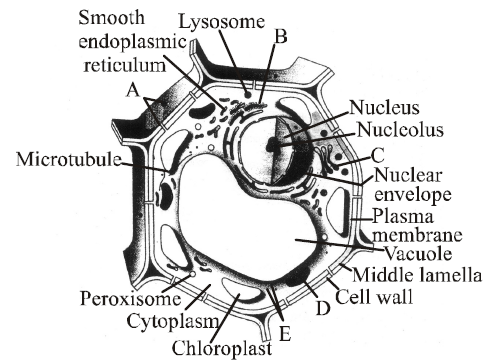
A. A - Plasmodesmata, B - Rough endoplasmic reticulum, C - Golgi apparatus, D - Mitochondrion, E - Ribosomes
B. A - Desmosome, B - Rough endoplasmic reticulum, C - Golgi apparatus, D - Mitochondrion, E - Ribosomes
C. A - Plasmodesmata, B - Smooth endoplasmic reticulum, C - Golgi apparatus, D - Mitochondrion, E - Ribosomes
D. A - Tight junction, B - Rough endoplasmic reticulum, C - Golgi apparatus, D - Mitochondrion, E -Ribosomes
Answer : A

A. A - Plasmodesmata, B - Rough endoplasmic reticulum, C - Golgi apparatus, D - Mitochondrion, E - Ribosomes
B. A - Desmosome, B - Rough endoplasmic reticulum, C - Golgi apparatus, D - Mitochondrion, E - Ribosomes
C. A - Plasmodesmata, B - Smooth endoplasmic reticulum, C - Golgi apparatus, D - Mitochondrion, E - Ribosomes
D. A - Tight junction, B - Rough endoplasmic reticulum, C - Golgi apparatus, D - Mitochondrion, E -Ribosomes
Answer : A
8. Polysome is a chain of
A. oxysomes
B. sphaerosomes
C. ribosomes
D. dictyosomes
Answer : C
A. oxysomes
B. sphaerosomes
C. ribosomes
D. dictyosomes
Answer : C
9. Microtubules, motor proteins, and actin filaments are all part of the
A. mechanism of photosynthesis that occurs in chloroplasts.
B. rough ER in prokaryotic cells.
C. cytoskeleton of eukaryotic cells.
D. process that moves small molecules across cell membranes.
Answer : C
A. mechanism of photosynthesis that occurs in chloroplasts.
B. rough ER in prokaryotic cells.
C. cytoskeleton of eukaryotic cells.
D. process that moves small molecules across cell membranes.
Answer : C
10. Which of the following statements are correct ?
A. (iii) and (iv)
B. (i) and (ii)
C. (ii) and (iii)
D. (i) and (iv)
Answer : A
- In prokaryotic cells, a special membranous structure formed by the extension of the plasma membrane into the cell is known as polysome.
- The smooth endoplasmic reticulum is the major site for synthesis of glycoproteins.
- RuBisCO is the most abundant protein in the whole biosphere.
- Mitochondria, chloroplasts and peroxisomes are not considered as part of endomembrane system. Of the above statements
A. (iii) and (iv)
B. (i) and (ii)
C. (ii) and (iii)
D. (i) and (iv)
Answer : A
11. The cell theory was given in year 1839 by Schleiden and Schwann. According to this theory all organisms are composed of cell and cells are the basic unit of life.
How did this theory help in the field of science?
A. It helped to study the working of cells.
B. It helped in curing diseases caused by cell.
C. It helped in restating the earlier theories on cell.
D. It helped in introducing the use of microscopes to study cell.
Answer : A
How did this theory help in the field of science?
A. It helped to study the working of cells.
B. It helped in curing diseases caused by cell.
C. It helped in restating the earlier theories on cell.
D. It helped in introducing the use of microscopes to study cell.
Answer : A
12. Match column-I (scientists) with column-II (discovery) and select the correct option.
A. A I, B III, C IV, D II
B. A I, B III, C II, D IV
C. A III, B I, C IV, D II
D. A I, B IV, C II, D III
Answer : A
| Column-I | Column-II |
|---|---|
| A. Leeuwenhoek | I. First saw and described a living cell |
| B. Robert Brown | II. Presence of cell wall is unique to plant cells |
| C. Schleiden | III. Discovered the nucleus |
| D. Schwann | IV. All plants are composed of different kind of cells |
A. A I, B III, C IV, D II
B. A I, B III, C II, D IV
C. A III, B I, C IV, D II
D. A I, B IV, C II, D III
Answer : A
13. Microtubules are absent in
A. mitochondria
B. centriole
C. flagella
D. spindle fibres
Answer : A
A. mitochondria
B. centriole
C. flagella
D. spindle fibres
Answer : A
14. Satellite means
A. terminal part of the chromosome beyond secondary constriction.
B. terminal part of the chromosome beyond primary constriction.
C. terminal part of chromosome beyond tertiary constriction.
D. none of the above
Answer : A /div>
A. terminal part of the chromosome beyond secondary constriction.
B. terminal part of the chromosome beyond primary constriction.
C. terminal part of chromosome beyond tertiary constriction.
D. none of the above
Answer : A /div>
15. The given diagram shows the sectional view of a mitochondrion.

Identify the parts labelled as A, B, C, D & E
A. A - Outer membrane, B - Inner membrane, C - Matrix, D - Inter- membrane space, E - Crista
B. A - Outer membrane, B - Inner membrane, C - Intermembrane space, D - Matrix, E - Crista
C. A - Outer membrane, B - Inner membrane, C - Matrix, D - Crista, E - Inter - membrane space
D. A - Outer membrane, B - Inner membrane, C- Crista, D - Matrix, E - Inter-membrane space
Answer : A

Identify the parts labelled as A, B, C, D & E
A. A - Outer membrane, B - Inner membrane, C - Matrix, D - Inter- membrane space, E - Crista
B. A - Outer membrane, B - Inner membrane, C - Intermembrane space, D - Matrix, E - Crista
C. A - Outer membrane, B - Inner membrane, C - Matrix, D - Crista, E - Inter - membrane space
D. A - Outer membrane, B - Inner membrane, C- Crista, D - Matrix, E - Inter-membrane space
Answer : A
16. Which of the following is absent in prokaryotes?
A. DNA
B. RNA
C. Plasma membrane
D. Mitochondria
Answer : D
A. DNA
B. RNA
C. Plasma membrane
D. Mitochondria
Answer : D
17. Identify the cell organelle given below. Which is an important site of formation of glyeoproteins & glycolipids
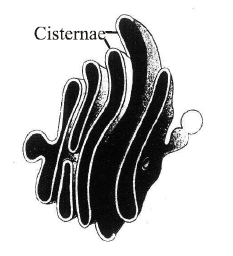
A. Rough endoplasmic reticulum
B. Smooth endoplasmic reticulum
C. Golgi body
D. mitochondria
Answer : C

A. Rough endoplasmic reticulum
B. Smooth endoplasmic reticulum
C. Golgi body
D. mitochondria
Answer : C
18. Which one of the following organelle given below is correctly matched with its function ?
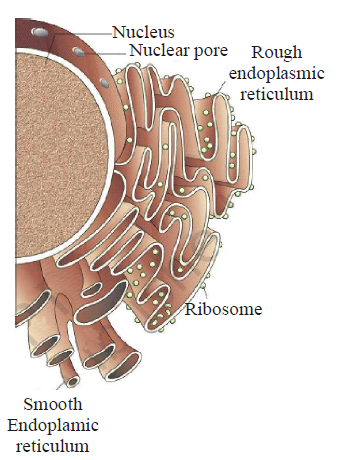
A. Golgi apparatus Protein synthesis
B. Golgi apparatus Formation of glycolipids
C. Rough endoplasmic reticulum Protein synthesis
D. Rough endoplasmic reticulum Formation of glycoproteins
Answer : C

A. Golgi apparatus Protein synthesis
B. Golgi apparatus Formation of glycolipids
C. Rough endoplasmic reticulum Protein synthesis
D. Rough endoplasmic reticulum Formation of glycoproteins
Answer : C
19. Read the folowing statements and identify the correct option.
A. (i) and (ii)
B. (ii) and (iv)
C. (i), (ii) and (iv)
D. None of the above
Answer : C
- Contractile vacuole takes part in osmoregulation and excretion.
- Food vacuole is formed by engulfing the food particles.
- The vacuole is bound by a double membrane called tonoplast.
- Vacuole can occupy upto 90 percent of the volume of the cell.
A. (i) and (ii)
B. (ii) and (iv)
C. (i), (ii) and (iv)
D. None of the above
Answer : C
20. In prokaryotes, chromatophores are
A. specialized granules responsible for colouration of cells
B. structures responsible for organizing the shape of the organism.
C. inclusion bodies lying free inside the cells for carrying out various metabolic activities.
D. internal membrane system which becomes extensive and complex in photosynthetic bacteria.
Answer : D
A. specialized granules responsible for colouration of cells
B. structures responsible for organizing the shape of the organism.
C. inclusion bodies lying free inside the cells for carrying out various metabolic activities.
D. internal membrane system which becomes extensive and complex in photosynthetic bacteria.
Answer : D
21. Which one of the following pairs is not correctly matched?
A. Cristae The tubular structure formed by the folding of the inner membrane of the mitochondrion.
B. Plasmodesmata The membrane surrounding the vacuole in plants.
C. Grana Membrane bound discs in chloroplasts that contain chlorophylls and carotenoids.
D. Middle lamella Layer between adjacent cells walls in plants derived from cell plate.
Answer : B
A. Cristae The tubular structure formed by the folding of the inner membrane of the mitochondrion.
B. Plasmodesmata The membrane surrounding the vacuole in plants.
C. Grana Membrane bound discs in chloroplasts that contain chlorophylls and carotenoids.
D. Middle lamella Layer between adjacent cells walls in plants derived from cell plate.
Answer : B
22. Which of the following organelles is directly connected to the outer membrane of the nucleus in a eukaryotic cell?
A. Mitochondrion
B. Lysosome
C. Golgi apparatus
D. Endoplasmic reticulum
Answer : D
A. Mitochondrion
B. Lysosome
C. Golgi apparatus
D. Endoplasmic reticulum
Answer : D
23. Nucleolus is
A. rounded structure found in cytoplasm near nucleus.
B. rounded structure inside nucleus and having rRNA.
C. rod-shaped structure in cytoplasm near the nucleus.
D. none of the above.
Answer : B
A. rounded structure found in cytoplasm near nucleus.
B. rounded structure inside nucleus and having rRNA.
C. rod-shaped structure in cytoplasm near the nucleus.
D. none of the above.
Answer : B
24. Function of RER is
A. autolysis
B. protein synthesis
C. lipid synthesis
D. carbohydrate synthesis
Answer : B
A. autolysis
B. protein synthesis
C. lipid synthesis
D. carbohydrate synthesis
Answer : B
25. The membrane of the erythrocytes has approximately ___% of proteins and ___% lipids.
A. 42, 50
B. 52, 40
C. 50, 50
D. 60, 40
Answer : B
A. 42, 50
B. 52, 40
C. 50, 50
D. 60, 40
Answer : B
26. Which of the following will determines the shape of the cells and provides a strong structural support to prevent the bacterium from bursting or collapsing?
A. Plasmids
B. Cell wall
C. Mesosome
D. Cell membrane
Answer : B
A. Plasmids
B. Cell wall
C. Mesosome
D. Cell membrane
Answer : B
27. Centrifugation of a cell results in the rupture of the cell membrane and the contents compacting into a pellets in the bottom of the centrifuge tube. Bathing this pellet with a glucose solution yields metabolic activity including the production of ATP. One of the contents of this pellet is most likely which of the following?
A. Cytosol
B. Mitochondria
C. Lysosomes
D. Golgi bodies
Answer : B
A. Cytosol
B. Mitochondria
C. Lysosomes
D. Golgi bodies
Answer : B
28. Given below are some characters of a cell organelle identify the correct organelle which shows all the characters described above.
A. Golgi apparatus
B. Lysosomes
C. Endoplasmic reticulum
D. Vacuoles
Answer : D
- It is a membrane bound space found in the cytoplasm.
- It is bound by a single membrane called tonoplast.
- It contains water, sap, excretory products and other materials not useful to the cell.
- It has higher concentration of sap than the cytoplasm.
A. Golgi apparatus
B. Lysosomes
C. Endoplasmic reticulum
D. Vacuoles
Answer : D
29. Match column-I with column-II and choose the correct option.
A. A IV; B III; C I; D II
B. A II; B III; C IV; D I
C. A IV; B II; C III; D I
D. A I; B III; C II; D IV
Answer : A
| Column-I | Column-II |
|---|---|
| A. Tonoplast | I. Contain digestive enzyme |
| B. Contractile vacuole | II. Store metabolic gases |
| C. Food vacuole | III. Excretion |
| D. Air vacuole | IV. Transport of ions in plants |
A. A IV; B III; C I; D II
B. A II; B III; C IV; D I
C. A IV; B II; C III; D I
D. A I; B III; C II; D IV
Answer : A
30. The following diagram represents a structure chromosome.
Identify the structures marked as A, B and C.
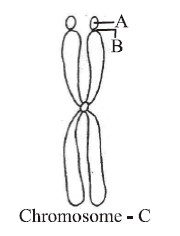
A. A - Satellite, B - Primary constriction, C - Acrocentric
B.A - Satellite, B - Secondary constriction, C - Metacentric
C. A - Satellite, B - Centromere, C - Telocentric
D. A - Satellite, B - Centromere, C - Submetacentric
Answer : B
Identify the structures marked as A, B and C.

A. A - Satellite, B - Primary constriction, C - Acrocentric
B.A - Satellite, B - Secondary constriction, C - Metacentric
C. A - Satellite, B - Centromere, C - Telocentric
D. A - Satellite, B - Centromere, C - Submetacentric
Answer : B
31. 9.A student was given cell samples (A and B) to identify parts which are highlighted. He observed the samples under the microscope and list down the function of the part of cell sample. The information collected by the student is listed in the table below, on the basis of which the student infers that the samples contain the organelles.
Explain why the samples were belonged to eukaryotic cell and not prokaryotic cell? Because,
A. eukaryotic cell have membrane bound organelles.
B. eukaryotic cell have non - membrane bound organelles.
C. eukaryotic cell are smaller and multiply more rapidly than prokaryotic cells.
D. eukaryotic cell are larger and multiply more rapidly than prokaryotic cells.
Answer : B
| Sample A | Sample B |
|---|---|
| Make energy available for cellular metabolism | Generates ATP and synthes izes s ugar |
| Absent in cell that carry oxygen throughout the body | Present in plant cell |
| Called the energy currency of cell | Source o f all the food energy |
Explain why the samples were belonged to eukaryotic cell and not prokaryotic cell? Because,
A. eukaryotic cell have membrane bound organelles.
B. eukaryotic cell have non - membrane bound organelles.
C. eukaryotic cell are smaller and multiply more rapidly than prokaryotic cells.
D. eukaryotic cell are larger and multiply more rapidly than prokaryotic cells.
Answer : B
32. Identify the components labelled as A, B, C, D and E in the diagram given below from the list (i) to (viii).
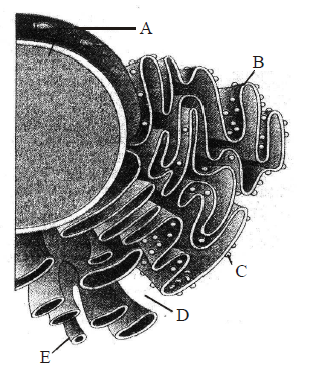
A. A - (viii), B - (v), C - (vii), D - (iii), E - (iv)
B. A - (i), B - (iv), C - (vii), D - (vi), E - (iii)
C. A - (vi), B - (v), C - (iv), D - (vii), E - (i)
D. A - (v), B - (i), C - (iii), D - (ii), E - (iv)
Answer : A

- Cristae of mitochondria
- Inner membrane of mitochondria
- Cytoplasm
- Smooth endoplasmic reticulum
- Rough endoplasmic reticulum
- Mitochondrial matrix
- Ribosome
- Nucleus
A. A - (viii), B - (v), C - (vii), D - (iii), E - (iv)
B. A - (i), B - (iv), C - (vii), D - (vi), E - (iii)
C. A - (vi), B - (v), C - (iv), D - (vii), E - (i)
D. A - (v), B - (i), C - (iii), D - (ii), E - (iv)
Answer : A
33. _______________ is the important site of formation of glycoproteins and golycolipids.
A. SER
B. Lysosome
C. Golgi apparatus
D. Mitochondria
Answer : C
A. SER
B. Lysosome
C. Golgi apparatus
D. Mitochondria
Answer : C
34. Chromosomes having equal or almost equal arms are called
A. metacentric
B. acrocentric
C. polycentric
D. acentric.
Answer : A
A. metacentric
B. acrocentric
C. polycentric
D. acentric.
Answer : A
35. Consider the following statements and choose the correct statement.
A. (i) and (iii)
B. (ii) and (iv)
C. (iii) and (iv)
D. (ii) and (iii)
Answer : D
- The endomembrane system includes mitochondria, chloroplast and peroxisomes.
- Smooth endoplasmic reticulum is the major site for synthesis of lipid.
- Rough endoplasmic reticulum is actively involved in protein synthesis.
- Mitochondrial matrix possesses single circular DNA, a few RNA and 80S ribosomes. Of the above statements.
A. (i) and (iii)
B. (ii) and (iv)
C. (iii) and (iv)
D. (ii) and (iii)
Answer : D
36. Study the following statements on cilium or flagellum and answer the question.
Which of the above statements are correct?
A. (i) and (ii)
B. (i), (ii), (iii) and (iv)
C. (i) and (iv)
D. (ii) and (iii)
Answer : B
- Cilium / Flagellum contains an outer ring of nine doublet microtubules surrounding two singlet microtubules.
- Cilia are smaller which work like oars, causing the movement of either the cells or surrounding fluid.
- Flagella are comparatively longer and responsible for cell movement.
- Cilium and flagellum are covered with plasma membrane.
Which of the above statements are correct?
A. (i) and (ii)
B. (i), (ii), (iii) and (iv)
C. (i) and (iv)
D. (ii) and (iii)
Answer : B
37. An organalle devoid of membrane covering is
A. vacuole
B. ribosome
C. peroxisome
D. lysosome
Answer : B
A. vacuole
B. ribosome
C. peroxisome
D. lysosome
Answer : B
38. Which of the following pair lack the unit membrane?
A. Nucleus and E.R.
B. Mitochondria and chloroplast
C. Ribosome and nucleolus
D. Golgi body and lysosome
Answer : C
A. Nucleus and E.R.
B. Mitochondria and chloroplast
C. Ribosome and nucleolus
D. Golgi body and lysosome
Answer : C
39. Which of the following is incorrect ?
A. Mycoplasma is the smallest cell (0.3 �).
B. Bacteria are 3 to 5 �m in size.
C. The largest cell is the egg of an ostrich.
D. Nerve cells are some of the smallest cells.
Answer : D
A. Mycoplasma is the smallest cell (0.3 �).
B. Bacteria are 3 to 5 �m in size.
C. The largest cell is the egg of an ostrich.
D. Nerve cells are some of the smallest cells.
Answer : D
40. Extension of plasma membrane in prokaryotic cell is
A. mesosome
B. haploid
C. ribosome
D. none of these
Answer : A
A. mesosome
B. haploid
C. ribosome
D. none of these
Answer : A
41. Read the statements given below with regard to the functions performed by Golgi apparatus ?
Which of the following is the correct answer ?
A. (i) is wrong but (ii) and (iii) are correct
B. (ii) is wrong but (i) and (iii) are correct
C. (ii) and (iii) are wrong but (i) is correct
D. All are correct.
Answer : D
- Transport and chemically modify the materials contained within it.
- Performs the function of packaging materials.
- Important site of formation of glycoproteins and glycolipids.
Which of the following is the correct answer ?
A. (i) is wrong but (ii) and (iii) are correct
B. (ii) is wrong but (i) and (iii) are correct
C. (ii) and (iii) are wrong but (i) is correct
D. All are correct.
Answer : D
42. Grana are
A. protein storing plastids.
B. coloured plastids.
C. stacks of thylakoids.
D. individual thylakoids present in stroma.
Answer : C
A. protein storing plastids.
B. coloured plastids.
C. stacks of thylakoids.
D. individual thylakoids present in stroma.
Answer : C
43. Identify the components labelled A, B, C and D in the given section of cilia/flagella showing different parts. Choose the option which shows the correct labelling of parts.
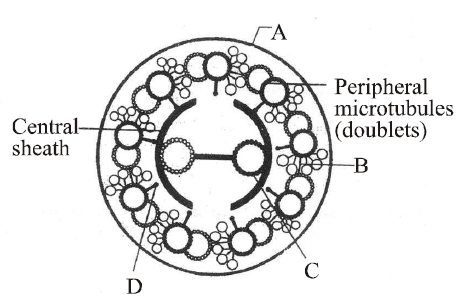
A. A Plasma membrane, B Interdoublet bridge, C Central microtubule, D Radial spoke
B. A Plasma membrane, B Arm, C Central microtubule, D Radial spoke
C. A Plasma membrane, B Interdoublet bridge, C Hub, D Radial spoke
D. A Plasma membrane, B Interdoublet bridge, C Hub, D Arm
Answer : A

A. A Plasma membrane, B Interdoublet bridge, C Central microtubule, D Radial spoke
B. A Plasma membrane, B Arm, C Central microtubule, D Radial spoke
C. A Plasma membrane, B Interdoublet bridge, C Hub, D Radial spoke
D. A Plasma membrane, B Interdoublet bridge, C Hub, D Arm
Answer : A
44. The fluidity of membranes in a plant in cold weather may be maintained by
A. increasing the number of phospholipids with unsaturated hydrocarbon tails.
B. increasing the proportion of integral proteins.
C. increasing concentration of cholesterol in membrane.
D. increasing the nuber of phospholipids with saturated hydrocarbon tail.
Answer : A
A. increasing the number of phospholipids with unsaturated hydrocarbon tails.
B. increasing the proportion of integral proteins.
C. increasing concentration of cholesterol in membrane.
D. increasing the nuber of phospholipids with saturated hydrocarbon tail.
Answer : A
45. Which one of the following combination is mismatched?
A. Glycocalyx May be capsule or slime layer
B. Pili Reproduction
C. Cell wall Protective, determines shape, prevents from bursting
D. Flagella, pili and fimbriae Surface structures of bacterial cell
Answer : B
A. Glycocalyx May be capsule or slime layer
B. Pili Reproduction
C. Cell wall Protective, determines shape, prevents from bursting
D. Flagella, pili and fimbriae Surface structures of bacterial cell
Answer : B
46. In which method of transport, plasma membrane does not require carrier molecule?
A. Active transport
B. Facilitated diffusion
C. Simple diffusion
D. Na+ K+ pump
Answer : C
A. Active transport
B. Facilitated diffusion
C. Simple diffusion
D. Na+ K+ pump
Answer : C
47. Which of the following terms is not correctly matched with its feature?
A. Osmosis Movement of water by diffusion.
B. Nucleoplasm Site of active synthesis of ribosomal RNA.
C. Mesosome Infolding of cell membrane and characteristics of eukaryotes.
D. Pili Elongated tubular surface structures (made of special protein) of bacteria.
Answer : C
A. Osmosis Movement of water by diffusion.
B. Nucleoplasm Site of active synthesis of ribosomal RNA.
C. Mesosome Infolding of cell membrane and characteristics of eukaryotes.
D. Pili Elongated tubular surface structures (made of special protein) of bacteria.
Answer : C
48. The lipid component of the membrane mainly consists of __________.
A. polysaccharides
B. phosphoglyceride
C. monosaccharaides
D. both (a) and (c)
Answer : B
A. polysaccharides
B. phosphoglyceride
C. monosaccharaides
D. both (a) and (c)
Answer : B
49. Integral proteins of cell membrane occur on/in
A. inner surfaces
B. outer surfaces
C. phospholipid matrix
D. inner and outer surfaces
Answer : D
A. inner surfaces
B. outer surfaces
C. phospholipid matrix
D. inner and outer surfaces
Answer : D
50. The diagram given below represent a filuid mosaic model of plasma membrance. Match the components marked as A, B, C, D and E in the diagram below from the list (i) to (vii).
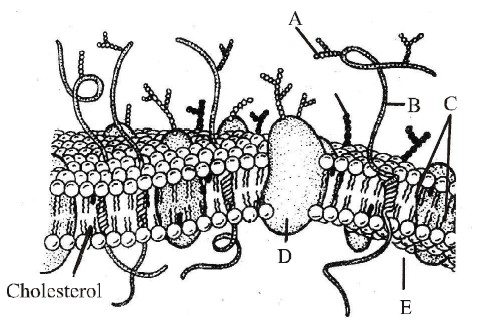
A. A - (i), B - (ii), C - (iii), D - (iv), E - (v)
B. A - (ii), B - (i), C - (iii), D - (iv), E - (v)
C. A - (i), B - (ii), C - (iii), D - (iv), E - (vi)
D. A - (i), B - (ii), C - (iii), D - (vii), E - (v)
Answer : A

- Sugar
- Protein
- Lipid bilayer
- Integral protein
- Cytoplasm
- Cell wall
- External protein
A. A - (i), B - (ii), C - (iii), D - (iv), E - (v)
B. A - (ii), B - (i), C - (iii), D - (iv), E - (v)
C. A - (i), B - (ii), C - (iii), D - (iv), E - (vi)
D. A - (i), B - (ii), C - (iii), D - (vii), E - (v)
Answer : A
Sharing is caring
Related Post
State of Matter MCQ Solved Paper for IIFT
Building Materials MCQ Solved Paper for NMAT
Building Materials 1000+ MCQ with answer for ISRO Recruitment
Machine Design 1000+ MCQ with answer for SSC CHSL
IBPS Clerk - Atomic Structure 1000+ MCQ [Solved] PDF Download
DRDO - Urinary Calculus Disease 1000+ MCQ [Solved] PDF Download